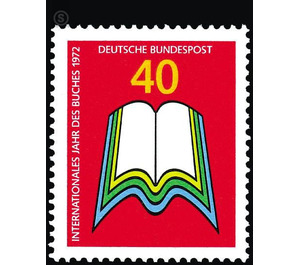International Year of the Book 1972 - Germany / Federal Republic of Germany 1972 - 40 Pfennig
Theme: Art & Culture
| Country | Germany / Federal Republic of Germany |
| Issue Date | 1972 |
| Face Value | 40.00 |
| Color | red |
| Perforation | K 13:13 1/2 |
| Printing Type | Multicolor offset printing |
| Stamp Type | Postage stamp |
| Item Type | Stamp |
| Chronological Issue Number | 629 |
| Chronological Chapter | GER-BRD |
| SID | 120108 |
| In 43 Wishlists | |
"Books for all" or "Everyone has the right to read" is - in a simple formula - the demand of the International Year of the Book, proclaimed by UNESCO for 1972. This requirement applies especially to the developing countries. To conquer illiteracy and to facilitate access to reading and to the book by obtaining the necessary printed material are urgent tasks of the society. As stated in the Charter of the Book, written in collaboration with Unesco by the international associations of authors, publishers, booksellers and librarians. In an appeal earlier this year, René Maheu, the director general of Unesco, said. a .: "Thousands of years ago it was the written word, for hundreds of years, it's the printed one that played such an important role in preserving the transfer of knowledge that shapes people's thoughts and ideas and conquers peace helped. The book is the most reliable and conventional means of communication man has ever devised, and with which he was able to conquer time and space for the first time. Anyone who has watched the development of the book as a means of communication in the last quarter of a century will also recognize the role and place of the book in the service of a new understanding of communication based on the mass media. In today's world, there is a tremendous need for reading that can even be called 'reading hunger' in large parts of the population. But while the technological revolution has long since transformed the production and distribution of books and can bring to market an ever-increasing number of relatively cheap, good-quality books, developing countries are still suffering from the dearth of books, the more noticeable they are more educational opportunities increase. Since developing countries currently do not produce more than one-fifth of the world book supply, they have to resort to foreign book imports to cover at least part of their needs. However, this situation can only be improved in the long term if a separate national publishing industry is established in these countries. But the problem is not just in quantity. Equally important, if not more significant, is that the book, as an unparalleled means of preserving knowledge and education, promotes the development of each individual and progress in society, making everyone the best the human mind can ever offer. learn and appreciate and that it serves the better understanding between the peoples, as a necessary step to a true and lasting peace. Even in countries where the publishing industry is flourishing, the book is by no means integrated into daily life. Although it is there, thanks to an extensive distribution system and a wide sales market, no problem to bring the book to the reader. But it is a real problem (though different in every country) to bring the reader to the book. The high percentage of non-readers identified by new research proves that. These issues should be considered once during the international book year. And beyond that, with the help of authorities, all sorts of institutions - whether regional, national or international - and with the help of private individuals, a solution to these problems should be sought. "In the Federal Republic of Germany, as in many other states, a special one for The Buchjahr formed committee took over the task to effectively support the initiative of UNESCO and the goals of the international book year. Graphic designer Beat Knoblauch was guided by the following ideas when choosing the subject and the design: On the subject of books: 1. The book is a wonderful medium for conveying people's thoughts between the ages on a worldwide level. 2. Books are bridges, they enable us to dialogue across borders. 3. Books are information stores, instruments of rapidly available knowledge. They are portable and easily accessible. 4. The book thus has and will probably retain its important and indispensable function, despite electricity and electronics. On the choice of motive: From the above-mentioned points the following attempt was made in the design of the motive: 1. to visualize the object "book" as a compact, symbolic, self-contained entity; 2. to present the sign or symbol "book" as new as possible, simple, memorable and yet aesthetic; 3. to provide insight through the "open" or "open" book, thus providing an incentive to read books; 4. to draw attention to the dynamic aspect of the book and its future through the perspective distortion of the sign "book"; 5. to indicate, on the one hand, the variety, the variety, the selection and, on the other, the internationality of the books or the book world through the "colored" pages.


